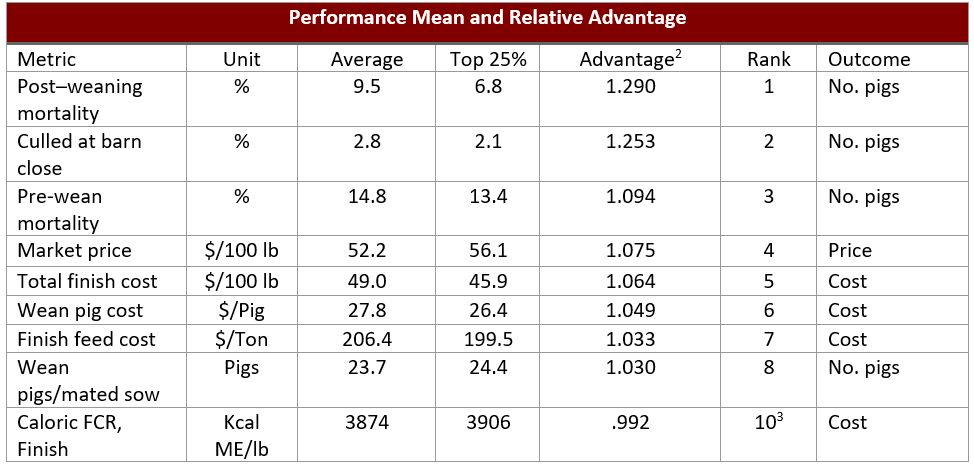



What does optimal FCR really mean?
As a genetic supplier, one of the first topics discussed in any meeting is feed conversion ratio (FCR). While a very easy value to calculate, it is important to know the relationship between FCR and profitability.by Derek Petry, Ph.D.
There are numerous factors that can contribute to the pigs FCR including: nutrition (i.e. pellets vs. mash, grind size, ingredients, etc.), housing (i.e. type of feeder, stocking density, temperature control, etc.), health, and genetics.
A paper written by Dr. Dean Boyd titled “Integrating Science into Practice and Getting it Right” determined the 10 most important metrics for profitability of the top 25% of firms (See Table 1; Boyd, 2012). Interestingly, FCR was ranked number 10, and the most profitable firms actually had worse caloric feed conversion ratio than the average firm. Thus, optimal FCR was more related to profitability than lowest FCR.
Table 1. Key differentiating metrics for profit in North America 1
1 Agri Stats Inc., March 2011 report for January – December 2010 (N = 68 firms)
2 Advantage = computed to be the fold-difference of the Top 25% over/under the average
3 Item 9, days to market, not shown but was equivalent for the Average and Top 25%.
The question really becomes, if we are trying to drive FCR as low as possible, what are we giving up and are we really driving profitability in the right direction? There are several ways to improve FCR, including, but not limited to:
- Selecting for faster growth while holding feed intake constant
- Selecting for lower feed intake while holding growth constant
- Selecting for faster growth and for lower feed intake. Each scenario has outcomes that may or may not be favorable with other production parameters.
Genesus has focused on maintaining feed intake at status quo and selecting for pigs that grow faster. This allows the Genesus pig to improve on FCR, yet handle stressors (i.e. diseases challenge, out of feed events, management, etc.) it encounters. Understanding how to feed an animal to its appetite and nutritional needs is critical to profitability. Since most genetic providers focus on FCR as a main trait they have pushed down the intake of the animal, and these can’t be fed the same way as animals that have a higher appetite. To get the best performance you must feed to the appetite and nutritional needs of that line and not to the lowest FCR, otherwise, as we have found, we are overfeeding things like lysine, energy, phosphorus and causing non-optimal performance and costing a lot of money (more detail to follow in Part 2 of this technical report). Clearly, cost per pound of gain is an important piece of profitability as feed represents 65-75% of the total cost of producing a slaughter pig.
Genesus is constantly testing its commercial progeny to ensure we know the best way to feed our animals and give nutritional recommendations to our customers. For example, Genesus provides pigs for Ralco’s nursery and finisher research barns to develop nutritional recommendations that lead to top performance with the lowest cost of gain.
References:
Boyd, R. D. (2012). Integrating Science into Practice and Getting it Right. The Howard Dunne Memorial Lecture. AASV.










